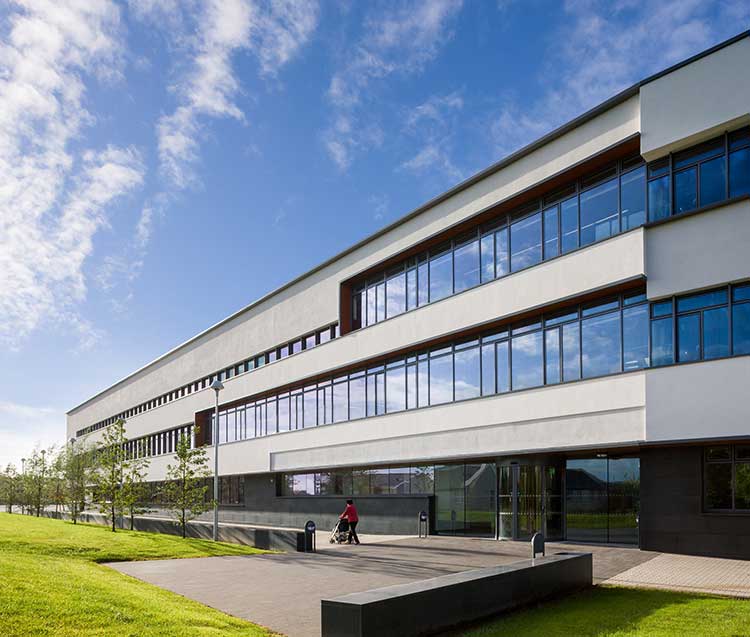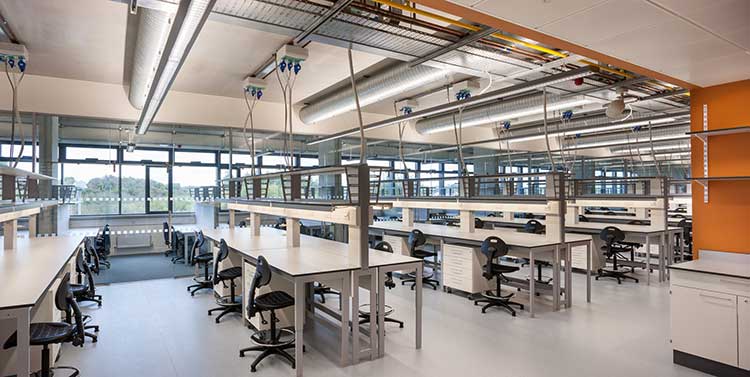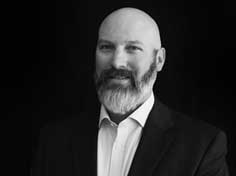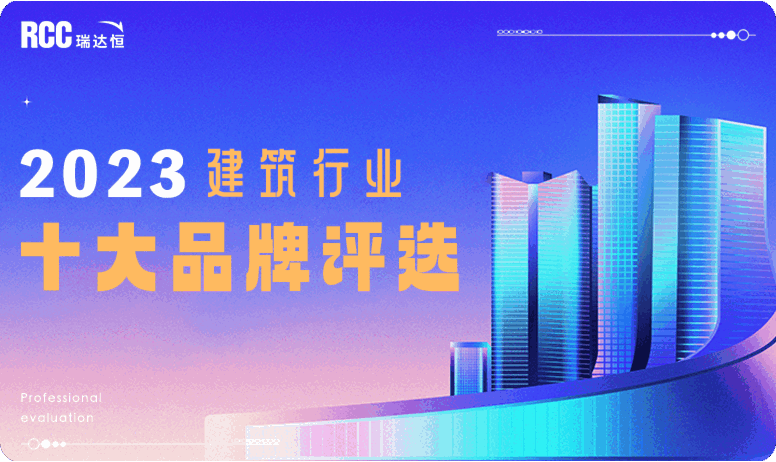Jeff Zynda:未来十年,实验室设计将大有可为
来源:畅言网 2017-09-20
畅言网:哪个项目最有挑战性?
JZ:从技术角度,最有挑战性的是生物防护设施。这种项目技术难度最大,属于专业性极强的设施。不过,我认为更大的挑战未必在于我们做的是什么类型的建筑,而是要改变人们对于科研建筑固有形式的理解。我们所做的不仅局限于达到技术要求,更关系到营造质的环境,创造办公场所。这也对科研起到了支持作用。许多人,无论是科学家还是关联人员,都没做好转变的准备。他们认为实验室环境是无菌科技环境。对他们而言,这和办公环境的品质无关。然而,面对行业的变化以及招聘顶尖科学人才的重要性,建筑正在发挥更大的支持作用。因此,相较于单纯满足科研建筑的技术要求,改变对科研建筑的认知实际上是更具挑战性的。这是另一种挑战和难题。
Archcy: Which project is the most challenging one?
JZ: From technical perspective, the most challenging project types are some of the biocontainment facilities that we designed. They are highly technical demanding, highly specific facilities. However, I think, the greater challenges that we have are unnecessarily what the building type, but changing people's perceptions about what science buildings can be. It's about not just meeting the technical requirements of science anymore. It's now about creating qualitative environment, it's about creating workplace. That is also in support of science. Many people, either scientists or people who contribute to the dialogue aren't ready to make that shift. They believe that the science environments are very sterile technical environments. To them, it is not about quality of workplace. But when we look at the changes in industry and the importance of recruitment of top science talent, buildings are playing a bigger role in support. So changing perceptions about research building is actually much more challenging endeavor than simply meeting technical requirements for the buildings for science that we do. It is the different type of challenge and difficulty.

爱尔兰国立高威大学(National University of Ireland) Photo by Warren Jagger Photography
畅言网:爱尔兰国立高威大学项目有哪些特别之处?
JZ:2006年到2013年期间,我参与了爱尔兰国立高威大学项目。我设计了三座不同建筑,分别是生物科学研究楼,科研图书馆,临床转化科研楼,它们位于不同场地上,但都包括在同一个标包里。项目属于爱尔兰“设计-新建-改造”新计划的组成部分。在这项计划当中,建筑师一开始先为高校工作,然后他们的工作合同再从高校转到建设方,监督完成整个施工过程。这一方法当时尚未在这种规模的项目上实施过,对和我共事的团队成员都是一次全新的实践经历。生物科学研究楼的特别之处在于,它集合了大学校园的若干科学院系和专业,并将其汇聚到同一屋檐下。这是我最早参与设计的第一座名副其实的聚合研究设施;它实现了超越多学科独立工作的真正意义上的聚合。这座建筑其他非常重要的部分都力求尽可能减少能源成本、运行成本和能耗。此外,项目仅为实验区域提供机械通风,不对建筑实施“一刀切”的通风模式。这一策略将能耗减少了60%以上。所有的办公空间、会议室和公共走廊都采用自然通风。这些区域完全没有机械通风。只有极为注重环境稳定性要求的自然科学空间、实验室和辅助区域,以及核心设施区域采用机械通风。同样,一个非常简单的策略却获得了极佳的节能效果,也使这座建筑荣获了2016年美国建筑师学会环境奖。这是我职业生涯中具有转折点意义的项目,我很荣幸能为它贡献力量。
Archcy: What made the National University of Ireland project special?
JZ: I had a unique opportunity to work at the National University of Ireland in Galway from 2006 to 2013, designing 3 different buildings, the Biosciences Research Building, the research library, the clinical translational research facility. These were all issued as one large tender package for three separate sites. These were part of a new process in Ireland called "Design-Build-Renovate". In this process, the architects start working for the university and then their contract transfers from the university to a builder to see the building through construction. This process had never been purely applied at this scale and was completely new to the team that I was working with. The Biosciences Research Building was unique in that it was taking a number of different science departments and disciplines from across the campus and bringing them together under one roof. That was one the very first truly convergent research facilities that I've been involved in designing; in a true sense of convergence beyond multi-disciplinary work. The other part of that building that was very important was trying to drive energy costs, operation cost, energy consumption, as low as possible. The strategy of providing only mechanical ventilation, only where was required for the lab components of the program, rather than the one-size-fits-all ventilation strategy for the building. This allowed us to reduce energy consumption by over 60%. All of the office spaces, conference rooms and public spaces corridors were all naturally ventilated. There was no mechanical ventilation in those parts of the building whatsoever. Only the hard science spaces, the laboratory and support areas, the core facilities are where environmental stability was critically important, that's where mechanical system is ventilated. Again, a very simple strategy, but resulted in extreme energy consumption reduction which allowed that building to win the 2016 AIA Committee on the Environment Award. A pivotal project in my career, I was very proud to be able to contribute to that.
畅言网:过去18年中,实验室设计发生了哪些变化?
JZ:有意思的是,尽管实验室需要改变,但广义上的实验室设计在过去的18年里并没有太多的变化。过去20年中的多数时间,科研活动都集中在基因组研究和生命科学方面。只有最近的六七年中,科学对话才开始从基因组科研等等转变到聚合科学上。我们看到,科学需求的不同组合正在进入这套生态系统。我认为,未来10年的科研设施设计将和过去20年截然不同。我们将看到更广泛的需求,也需要更具合作性的环境。聚合的理念将占据主导,不同专业的科研工作者们将以前所未有的方式一起工作。例如,生物学家可能同经济学家合作,或者同计算机科学家共同解决研究课题。这将随之产生完全不同于常规湿式实验室的实验环境,会打破许多人构想的实验室空间。尽管过去数年中存在不同的规划方法和侧重点,但过去的变化并没有很多。未来的十年才是真正令人振奋的。
Archcy: How has laboratory design been evolving during the last 18 years?
JZ: Interestingly, laboratory design in a popular sense has not evolved much over the past 18 years although it needs to. The most of the past better part of 20 years has been focused on genomic based research and life science research. Only recently, in the past 6 or 7 years has the dialogue started to shift from genomic science in general to now more convergence science. We are seeing different group of scientific needs coming into the eco system. I believe the next 10 years of research facility design will look very different from the past 20. We will see much broader spectrum of needs. We will require a much more collaborative environment. We will see the idea of convergence taking hold, different group of researchers coming together in a fashion that they've never had to before. For example, a biologist might be working with an economist, might be working with a computer scientist to solve a research issue. That will lead to a very different laboratory than a typical wet bench science laboratory that many people have formed as a vision of what a laboratory looks like. It is not so much about looking back at what has changed because there's been a lot of the same even though there's been different planning approaches and different focuses over the years. The next 10 years is really what's exciting to me.

爱尔兰国立高威大学(National University of Ireland) Photo by Warren Jagger Photography
畅言网:目前为止,您在中国的旅行有何感受?
JZ:对于首次来北京的人来说,我现在所观察到的大体都是大家了解的内容。但最大的意外是,来北京前,我无法体会到这个城市的尺度。城市有多大,多有活力。来之前,这只是个地图上的城市。不过来到这里后花了点时间到处转转,就会发现北京是个迷人的地方。古老的中国建筑和现代建筑既差异鲜明,又共荣共存,这一点深深地吸引着我。我真的很高兴来到这里,希望对中国有更多的了解,也希望能继续拓宽眼界,希望我在中国的经历能够有助于拓展实践工作。
Archcy: How is your trip to China so far?
JZ: My observations thus far are probably pretty normal for someone visiting Beijing for the first time. The biggest thing that surprised me is that I previously had little appreciation for the scale of Beijing before I came here. How large this city is, how vibrant it is. From afar, it is a place on the map. But having had a little bit of time to tour throughout the city, it is a fascinating place. In intrigued by the rich dichotomy of ancient Chinese architecture and more recent modern interventions; they present a fascinating juxtaposition. I am really excited to learn more about China and see how I can continue to broaden my own perspectives and hopefully broaden the work that I do from my experiences here.
畅言网:据悉,北京怀柔将建立新的科学城。Perkins+Will会参与该项目吗?
JZ:我也听说了,我们期望能参与科学城设计。这是一个激动人心的项目,这使我们能有机会运用我们的专长从头开始构想一座全新的城市。我认为,重要的是将对的基础要素和对的基础设施落实到位,不仅要创造一系列建筑,还要围绕科学城打造相关文化。这也是我们公司实践工作的部分内容。要从区域规划角度思考城市,不仅在宏观层面上,还要从建筑层面上开展总体规划,反复考量这两个层面的相互作用与影响,从而创造富有活力的科学城。我们不仅要形成建筑群,更要打造科研文化氛围。
Archcy: A new science city will be built in Huairou, a suburb of Beijing. Would Perkins+Will participate in this project?
JZ: We've heard the same thing and we've very much hoped that we can be a participant in the science city. It is a very exciting endeavor to be able to conceptualize a whole city based on what we do and do that from the ground up because I think that putting the right foundational elements, the right infrastructure in place, to create not only just a series of buildings, but really create a culture around a science city is important. And that is part of what our practice does. It is to think of city in district planning, at not only the master planning at the macro level, but also at the building level, and how those two factors work back and forth in order to create a vibrant science city. That is not just be a collection of buildings, but is about creating a culture for research.
畅言网:您对城市化有何见解?
JZ:我觉得无论城市规模如何,人们都需要和所在场所产生联系。处理不同尺度的城市问题变得越来越重要。人们希望感到自己是工作和生活所在地社区的一员。他们同所在社区的融入感越高,生活品质也会随之提升。看看北京的城市规模,2000多万人口,但其实很少有人在2000万人的尺度层面上和城市产生联系,他们更多的是在社区层面或者有认同感的区域层面与城市形成联系。在不断做规划的过程中,无论对于新科学城,还是新的开发项目,我们都不能丢掉设计中的人的因素,因为这才是真正场所感的源头所在。
Archcy: What is your view on urbanism?
JZ: My view is that no matter what the scale of the city, people need to feel connected to the places that they are in. Ever increasingly, dealing with urban issues at a variety of scales is important. People want to feel like that they are part of the community that they live in or work in. The more they are connected to the place in which they live and work, the quality of their lives tends to increase. When you look at the size of Beijing, more than 20 million people, very few people can connect to the city at the 20 million person level, but they can very much connect with the city in a neighborhood level and the places they personally identify with. As we continuously plan, either for a new science city, or for a new development, it is about making sure that we don't lose that human factor in design that people can connect with because that is where the real sense of place originates from.
畅言网:城市规划方面,波士顿能给北京提供范例吗?
JZ:有趣的是将北京和波士顿做比较,波士顿是很小的,人口不到100万。波士顿并不是一座经过规划的城市,而是随时间的推移有机发展起来的,是美国最早发展起来的城市之一。我认为波士顿的新城市发展经验同城市发展史完全不同。它的独特之处在于,城市和根植于所在社区的历史依然保持着联系,人们在步行层面上和城市是有关联感的。我觉得这是许多人喜欢波士顿的原因,但我这里所说的是从量化角度出发的,并不是规划的视角。步行层面的城市互动是波士顿的精髓所在。
Archcy: Could the city of Boston serve an example of urban planning for Beijing?
JZ: The interesting thing is that comparing Beijing to Boston, Boston is very small. It is less than 1 million people. It is not a planned city at all. Boston has grown organically over time, one of the very first cities developed in the United States. I think the lessons in new urbanism will be completely different from the history of Boston’s development. What is unique to Boston is still that it has a connection to history, rooted in its community and has a connected feel at pedestrian level. I think this is what makes a lot of people like Boston from more of a qualitative perspective rather than a planning perspective. It is about that urban interaction at a pedestrian level that is the essence of the city.
畅言网:您在读什么书?
JZ:我确实会经常读书,不过目前没有特别专注在某一本书上。我看各种不同的书,有关于领导力的,更多的是透过商业视角和社会政治角度来检视我们如何受到全球经济和变化影响的书。我往往会同时读三四本书。每本都只读了一点,常常看了一部分就没了兴致。把书通篇读完要花不少时间。我发现要找到自己真正有兴趣的书也很费工夫。我喜欢读很多历史方面的书,最近我在刻意尝试放下历史书,把注意力更多地放到小说上去,但目前还不大奏效。
Archcy: What are you reading?
JZ: I do read quite a bit, but I’m a little bit unfocused right now. I am reading a variety of different things from books about leadership, more of a business perspective to how we are all affected by global economy and changes in the world, from the sociopolitical point of view. I tend to read about three or four books at a time. Unfortunately, I read a bit of each one, and often lose interest in some during that process. It takes me a good while to read through them completely. I find it takes me some time to find books that I really connect with. I enjoy reading a lot of history and I am trying to consciously take a pause from reading about history and read more fiction although not very successfully right yet.
畅言网:您下一步有何计划?
JZ:使我领导的部门不断发展壮大。下一步是梳理整理我刚才谈到的聚合科研会带来哪些影响,优化完善我们为推动科学进步所运用的工作理念,明确其对科研建筑意味着什么。这就是我目前的工作重点,不是回顾过去,而是展望未来,思考如何为人们创造更好的空间,如何通过更好的空间来加快科学发现,解决一些全球范围内有关人类健康和科学进步的更大难题。
Archcy: What's next?
JZ: It is continuing to grow the practice which I lead. The next step is to codify what the impact of the convergent agenda I previously spoke about is and how do we refine our idea about how sciences are advancing and what does that mean for the architecture of science. That is what I am really focused on now, not so much looking back, but looking forward, how do we create better spaces for people, how do we create better spaces to accelerate and advance discovery to solve some of the harder issues around the world that are related to human health and the advancement of science.
发表评论
最新评论

 投稿
投稿









